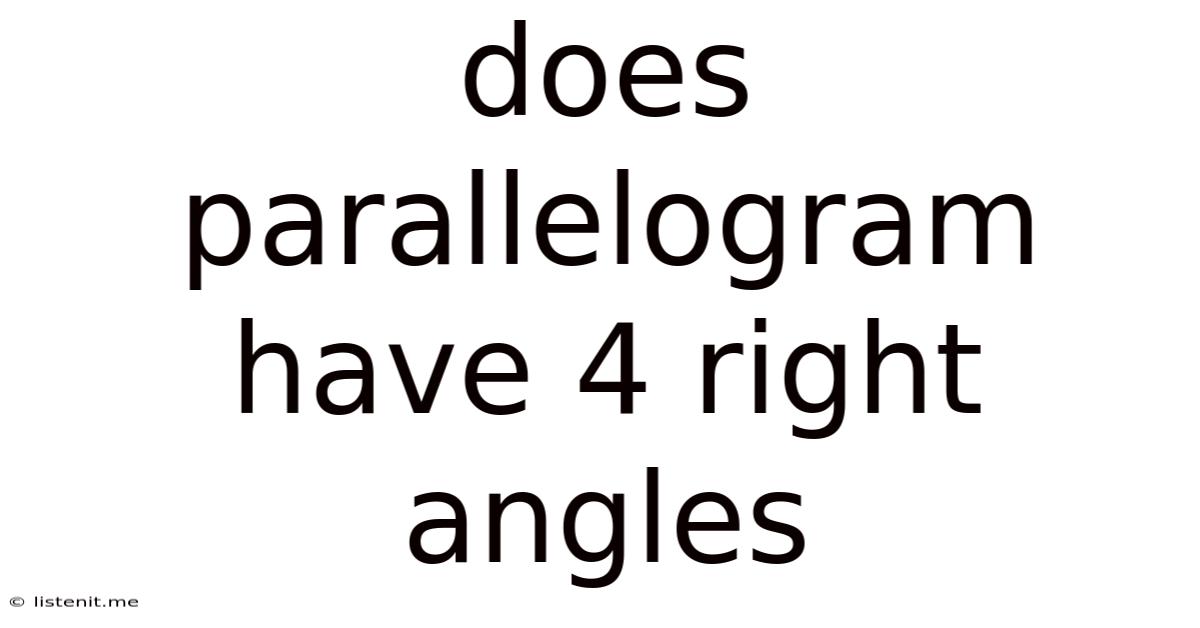Does Parallelogram Have 4 Right Angles
listenit
May 09, 2025 · 4 min read

Table of Contents
Does a Parallelogram Have 4 Right Angles? Exploring Quadrilateral Properties
The question, "Does a parallelogram have 4 right angles?" is a fundamental one in geometry, touching upon the properties of quadrilaterals and the relationships between different shapes. The simple answer is no, but understanding why requires a deeper dive into the definitions and characteristics of parallelograms and other related shapes. This comprehensive exploration will dissect the properties of parallelograms, contrasting them with rectangles and squares, and clarifying the misconceptions surrounding their angles.
Understanding Parallelograms: A Definition
A parallelogram is a quadrilateral, meaning a four-sided polygon. What distinguishes a parallelogram from other quadrilaterals are its specific properties:
- Opposite sides are parallel: This is the defining characteristic. If you draw a line extending one side of a parallelogram, it will never intersect the opposite side, no matter how far you extend the lines.
- Opposite sides are equal in length: The lengths of opposite sides are congruent.
- Opposite angles are equal: The angles opposite each other within the parallelogram are of the same measure.
- Consecutive angles are supplementary: This means that any two angles next to each other add up to 180 degrees.
These properties are interconnected and interdependent. The parallelism of opposite sides directly implies the equality of opposite sides and angles. The supplementary nature of consecutive angles is a consequence of parallel lines intersected by a transversal (the parallelogram's sides).
Visualizing Parallelograms: Beyond the Basic Shape
It's crucial to visualize parallelograms in various orientations. They don't always appear as the typical tilted "leaning" shape. A parallelogram can be:
- Slightly slanted: This is the most commonly depicted parallelogram.
- Almost rectangular: A parallelogram can be very close to a rectangle, appearing almost rectangular but still subtly tilted.
- Highly skewed: It can be significantly slanted, with angles far from 90 degrees.
This variety of shapes highlights that the presence of parallel sides is the key defining feature, not the appearance of right angles.
Rectangles: A Special Case of Parallelograms
A rectangle is a special type of parallelogram. It satisfies all the properties of a parallelogram and adds one crucial condition:
- All angles are right angles (90 degrees): This is the defining characteristic that distinguishes a rectangle from a general parallelogram.
Therefore, while all rectangles are parallelograms, not all parallelograms are rectangles. The rectangle represents a subset of parallelograms with the additional constraint of having four 90-degree angles.
Squares: The Most Specialized Parallelogram
A square takes the specialization even further. It's a rectangle with an added property:
- All sides are equal in length: This adds to the properties of a rectangle (and thus a parallelogram).
A square is a parallelogram, a rectangle, and a rhombus (a quadrilateral with all sides equal), possessing the characteristics of all three. Its four 90-degree angles solidify its place within the rectangle and parallelogram families.
Why Parallelograms Don't Always Have 4 Right Angles
The fundamental reason why a parallelogram doesn't necessarily have four right angles boils down to the definition. The only defining condition for a parallelogram is the parallelism of its opposite sides. The angles can vary, ranging from slightly less than 90 degrees to significantly more. The sum of interior angles in any quadrilateral is always 360 degrees, but this doesn't constrain individual angles to 90 degrees. If a parallelogram did have four right angles, it would automatically qualify as a rectangle (and potentially a square if its sides were also equal).
Misconceptions and Clarifications
The confusion often stems from a limited exposure to diverse parallelogram shapes. Students often associate parallelograms solely with their slightly slanted representations, leading to the mistaken belief that right angles are inherent. The diversity of parallelogram shapes needs emphasis to dispel this misunderstanding.
Exploring Related Quadrilaterals
Understanding the relationship between parallelograms and other quadrilaterals helps solidify the concept. Let's briefly touch upon a few:
- Rhombus: A rhombus has all four sides equal in length, but its angles are not necessarily right angles. It's a parallelogram, but not necessarily a rectangle or square.
- Trapezoid (or Trapezium): A trapezoid has only one pair of parallel sides, unlike the two pairs in a parallelogram.
- Kite: A kite has two pairs of adjacent sides that are equal in length, but its opposite sides are not parallel.
Practical Applications and Real-World Examples
Understanding parallelogram properties has practical applications in various fields:
- Engineering: Analyzing forces and structures often involves parallelogram models.
- Physics: Vectors are often represented using parallelograms to illustrate their addition and resolution.
- Computer Graphics: Parallelograms are fundamental shapes used in 2D and 3D modeling and rendering.
Conclusion: A Definitive Answer
To reiterate, the answer remains a resounding no. A parallelogram does not always have four right angles. While rectangles and squares (which are special cases of parallelograms) possess this property, the defining characteristic of a parallelogram is the parallelism of its opposite sides, irrespective of its angles. Understanding this distinction is crucial for grasping fundamental geometric concepts and their applications in various fields. Visualizing parallelograms in their diverse forms helps dispel misconceptions and solidify a thorough understanding of their properties.
Latest Posts
Latest Posts
-
Fill In The Orbital Energy Diagram For The Nitride Ion
May 09, 2025
-
In Which Cell Organelle Does Photosynthesis Occur
May 09, 2025
-
Two Planes Intersect In Exactly One Point
May 09, 2025
-
How To Find Maximum Area Of A Rectangle
May 09, 2025
-
150 Is 15 Of What Number
May 09, 2025
Related Post
Thank you for visiting our website which covers about Does Parallelogram Have 4 Right Angles . We hope the information provided has been useful to you. Feel free to contact us if you have any questions or need further assistance. See you next time and don't miss to bookmark.